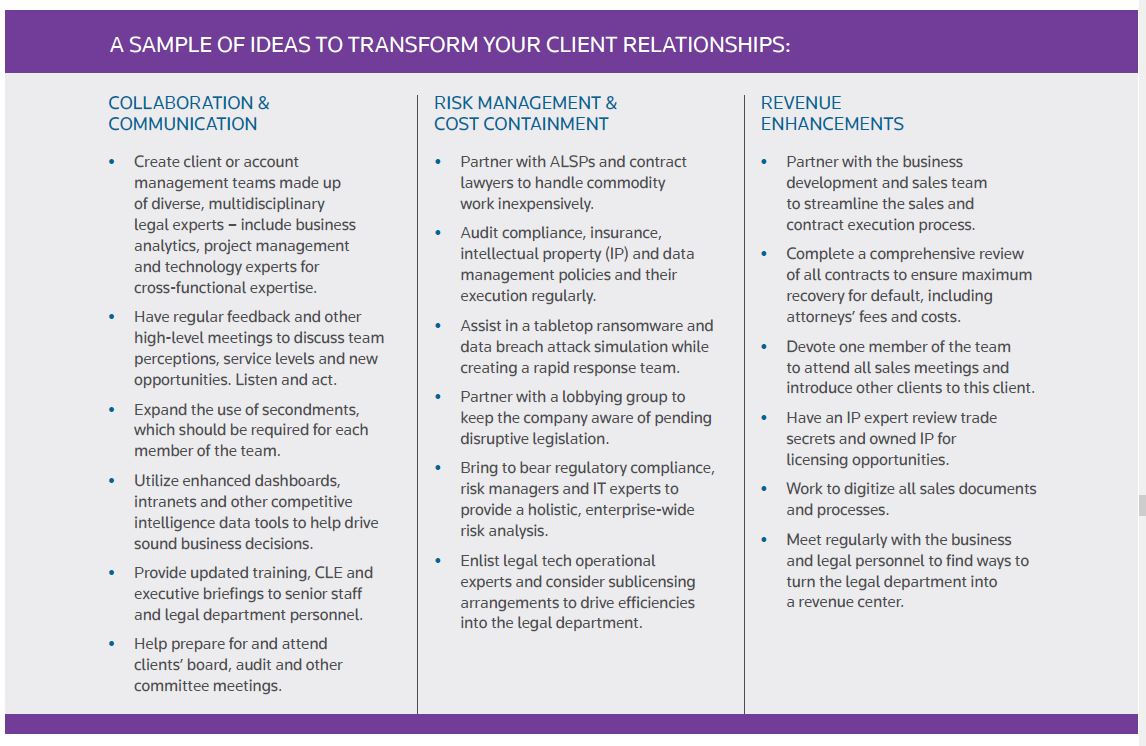The large law firm market is doing very well in terms of rates, demand, productivity and expenses — and firms are very busy. Why is this happening?
Recent Thomson Reuters data from the second quarter of this year showed that the large law firm market saw dramatic increases in both key metrics of legal demand and productivity. Even better, overhead expenses continued to shrink, resulting in substantial increases in profitability.
While some may argue that these increases may be due to the pandemic-driven low baseline of last year, pent-up legal demand, courts opening up or the cheap cost of money driving M&A deals, there are other factors responsible for this explosive growth.
The risk spectrum has expanded
These are certainly unusual times in the legal industry. From climate change to social unrest, today’s general counsel and their companies are dealing with issues never seen before. Everything from increasing health risks to employees and customers due to the pandemic, masking and vaccination issues to the new realities of remote working, with accompanying issues of legal, human capital and technology challenges, and how it will play out going back into the office.
In addition, new technologies and expansion of privacy rules, regulations and laws have created a compliance nightmare, while continuous data breaches and increased ransomware attacks show that no one is safe.
On the macro front, companies and their legal teams can be impacted by political issues, such as voting rights, immigration, supply chain disruptions, vendor verification, management and trade, as some of these challenges will necessitate a retooling of production and distribution systems. Not incidentally, major global issues such as sustainability, climate change, energy efficiency and the de-carbonization of industry are now being driven by companies rather than government.
Social issues such as environmental, social & corporate governance (ESG) initiatives; diversity, equity & inclusion (DEI) goals; racial equality; women’s rights; and employee well-being around mental health issues are also now at the forefront of what shareholders, customers and the community expect from organizations.
Finally, many legal teams are dealing with the increasing impact of artificial intelligence and the digitization of the business, which is changing the way many legal departments do business.
These issues are relatively new and these seismic shifts in enterprise-wide risk management are creating new headaches for companies which, in turn, create new opportunities for lawyers who can help these organizations navigate these disruptive times.
The transactional relationship
While cost and convenience caused an exponential growth in in-house legal teams over the last 20 years, the pandemic and expanded risk areas have shown that outside law firms are needed more than ever. The in-house legal department often doesn’t have the scale and cross-functional depth of expertise to effectively handle all of these issues.
As a result, and especially for those law firms with expanded services and significant geographical reach, the good times look to continue… at least for a while. However, does that mean law firms should be content to cruise along without making changes in how they conduct business and interact with their clients?
Clients today have more power and choices to select a legal provider than ever before; as a result, they are dictating terms, price, working conditions and the makeup of team members.
Not at all. There’s just too much competition from existing firms and new alternative legal service providers in the legal market. Indeed, without strategic planning and proper investment, many law firms may face unrecoverable disruption.
For most of its history, law has been a transactional business. When the transaction or litigation was completed, the file was closed. Both clients and their law firms then moved on to the next matter. Clients may have wanted and needed more, of course, but lawyers who were versed in their own specialty never really viewed the client in a holistic way. This failure was a material factor in driving the expansion of the in-house legal department as many general counsel were forced to become strategic risk and revenue advisors, perched at the top of the house and guiding the company through legal, financial and regulatory minefields.
In this all-inclusive role, the in-house legal team became transformational, which set the tone for overall protection and growth of the company’s assets.
The transformational relationship
In a complex and fast-changing world, transactional relationships are dead.
It’s now time for law firms to turn their transactional relationships into transformation partnerships where they effectively serve as an extension of the client and its in-house legal department. Clients want this connection because it serves their best interests by having the breadth and depth of a law firm’s resources standing behind them as they deal with this onslaught of disruptive risk factors. Clients also want a team approach that includes various disciplinary experts, as well as a diverse team that features younger lawyers.
Clients today have more power and choices to select a legal provider than ever before; as a result, they are dictating terms, price, working conditions and the makeup of team members. In short, clients clearly want to be regularly heard, get proactive briefings and help reporting key information up the chain of command. They also want operational advice with enough data connections and analytics to drive proper decision-making.
In short, clients want their outside law firms to know their business, industry and competitive threats as much as clients themselves do.
This “extension of your client’s business” relationship requires law firms to take a team approach. No longer can firms trust a key relationship only to a relationship partner, and the idea of one lawyer owning the client no longer makes sense from a collaboration, succession or business standpoint. In fact, law firms that fail to recognize this change in mindset may leave the client with no other choice but to seek a comprehensive approach elsewhere, simply because today’s business and legal issues are too intertwined for these one-off relationships to succeed.
Changing the paradigm
Now is the time for law firms to take bold action. Due to the pandemic, many lawyers are re-evaluating what they want out of work and how they want to work, causing firms to adjust to their wishes or possibly lose the lawyer and key clients. Even for firms that don’t have mandatory retirement requirements, the pandemic has shown many older lawyers just how short life can be, and many may opt out for an earlier than anticipated exit. These shifting tides, along with massive technological changes, present innovative law firm leaders with a “pandemic opportunity” to remake the client relationship and their business model to compete more effectively in the 21st century.
Today’s world of complex interwoven business issues calls for a more intimate attorney-client relationship. Clients view all issues through a multifaceted business lens – sometimes with a legal component. Moving from a legal services vendor to a transformational advisor takes collaboration, business insight and most of all, investing the time to learn from and listen to the client.
In a transactional attorney-client relationship, you’re only a vendor subject to intense discounting of fees, continuous RFPs, reverse auctions and replacement during a convergence process. By becoming a true transformation partner – and thus an extension of your client’s business – lawyers can make themselves indispensable, helping them see around the corner and navigate these highly unusual times.







